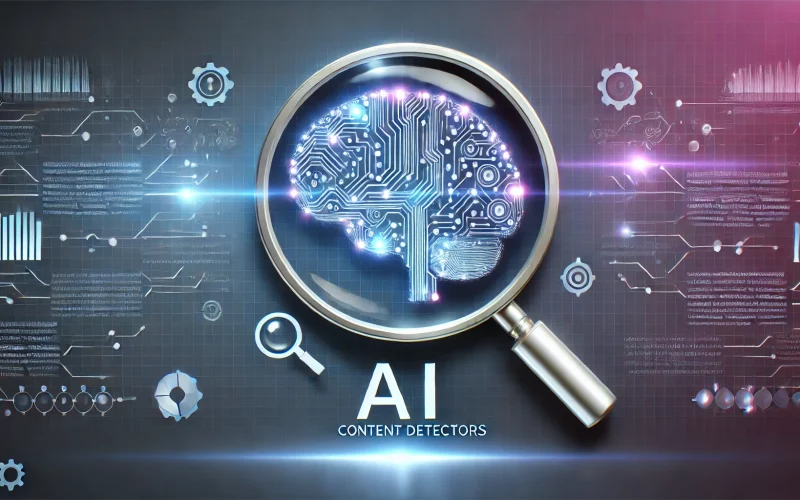Introduction
In today’s rapidly changing AI landscape, the term “Detector de IA“ (AI detector) has taken on new significance. As more content is produced using AI tools like ChatGPT, Bard, and Claude, it has become critical to identify the origin of such content. This tool, known as a Detector de IA, analyzes written content to determine whether it was generated by artificial intelligence or a human. These detectors are used across various industries, including education, digital marketing, journalism, and more, to maintain authenticity and credibility in content.
AI-generated content, while efficient and often useful, can raise ethical concerns when used deceptively or in environments where originality is crucial. Whether you’re a teacher checking student essays, a content marketer ensuring Google compliance, or a recruiter evaluating job applications, AI detection tools can help you stay one step ahead.
What is a Detector de IA?
A Detector de IA is a tool that scans and analyzes written text to figure out whether it was written by a human or by an AI model. These detectors use smart algorithms to look for patterns, repetition, and unnatural phrasing often found in AI-generated text.
AI detectors are built using machine learning. Developers train them with examples of both human-written and AI-written text. Over time, the detectors learn the difference between natural human writing and the structured, sometimes predictable style of AI content.
These tools don’t always give a 100% clear answer, but they can often say whether a text is “likely AI-generated,” “possibly AI-generated,” or “likely written by a human.”
Why Are AI Detectors Important?
As AI becomes more powerful, its use is spreading to many areas. While AI content can be helpful, it can also be misused. Some of the key reasons why Detector de IA tools are so valuable include:
1. Promoting Honesty in Education
Students can now easily use AI tools to write essays, reports, or even answers on exams. While some use is fine, schools and universities still expect original work. Teachers and academic institutions use Detector de IA tools to check whether student submissions were created with the help of AI.
This helps promote fairness, effort, and learning, while discouraging cheating or over-reliance on technology.
2. Ensuring Originality in Digital Marketing
Marketers are using AI to write blogs, product descriptions, and even emails. While this can speed up work, it also risks producing content that Google or other search engines may see as low-quality or duplicate. Detector de IA tools help content marketers verify that their content is original and safe for SEO.
Original content not only performs better but also builds trust with readers and customers.
3. Supporting Journalism and Media Integrity
Journalists must deliver accurate and credible stories. With the rise of AI-written news articles, it’s important for editors and media outlets to confirm whether content was written by a human reporter or by a machine. Detector de IA tools help maintain trust in news sources and reduce the risk of fake or low-quality articles.
4. Improving Hiring and Recruitment
In the job market, resumes, cover letters, and application essays are often written by applicants themselves. Now, some people use AI tools to write these documents. Recruiters and HR teams use AI detectors to check for authenticity and ensure that a candidate’s words truly reflect their skills and character.
5. Encouraging Responsible AI Use
There is nothing wrong with using AI tools, but using them without disclosure can be misleading. Detectors help promote ethical AI use by keeping everyone accountable.
Where Detector de IA Tools Are Being Used
1. Schools and Universities
Teachers, examiners, and academic boards are using AI detectors to maintain academic integrity. They can detect AI-written assignments, helping prevent unfair advantages.
2. Online Publishers
Bloggers, SEO agencies, and media companies rely on Detector de IA to check whether articles are authentic and safe for search engines.
3. Corporate Offices
In training programs, HR communications, and internal reports, companies want clear, original writing. Detectors help check for overuse of AI in official materials.
4. Government and Legal Fields
Legal writing, policy documents, and public communications require accuracy and accountability. Detectors ensure these important texts are not overly AI-reliant.
5. Freelance Platforms
Platforms that connect writers with clients may use Detector de IA tools to verify that submitted work is human-written and high quality.
How Do AI Detectors Work?
AI detectors function through sophisticated algorithms that examine the structure, patterns, and predictability of a given text. Most modern AI detectors rely on three primary techniques:
1. Perplexity Analysis
Perplexity measures how predictable a word or sentence is in a given context. Because AI content follows more consistent and repetitive patterns, it usually results in lower perplexity scores. In contrast, human writing is usually more varied and unpredictable.
2. Examining Burstiness
Burstiness describes the fluctuations in sentence structure and length within a piece of text. Human authors often mix long and short sentences, while AI tends to generate uniform sentence structures. AI detectors use this inconsistency (or lack thereof) to identify machine-written content.
3. Role of Machine Learning & NLP
To recognize writing patterns, AI detectors rely on large datasets featuring a mix of human-created and AI-produced text. Using NLP and machine learning, these tools can recognize subtle differences in tone, syntax, and rhythm that distinguish human writing from AI output.
Importance of AI Detectors
As AI-produced content becomes more common, it creates new possibilities—alongside complex issues to address. While AI can boost productivity and assist with content creation, it can also lead to misuse if not properly managed. Essential Role of AI Detectors:
- Upholding Academic Standards: Educational institutions rely on AI detectors to verify the originality of student submissions.
- Ensuring Content Quality for SEO: Search engines like Google prioritize human-first, high-quality content. Using AI detectors helps marketers avoid penalties.
- Upholding Journalistic Standards: In journalism, credibility is everything. AI detectors help verify the authenticity of articles and reports.
- Preventing Fraud in Recruitment: Employers use AI detection to ensure candidates are submitting original writing samples or cover letters.
Top AI Detection Tools to Know
A look at some of the most reliable tools available today.
| Tool Name | Features | Best For |
| GPTZero | Free to use, highlights AI-generated sentences | Education, Journalism |
| Originality.ai | Built for SEO professionals, team collaboration | Content Marketing |
| Copyleaks | Offers plagiarism and AI detection in one tool | Academic, Corporate Use |
| Writer.com Detector | Easy to use, gives a score for AI probability | Casual Bloggers, Writers |
| Turnitin AI Detector | Integrated with many school systems | Educational Institutions |
These tools vary in complexity and use cases, but all serve the purpose of identifying and analyzing AI-generated content.
AI Detection: Key Limitations
AI detector tools offer great benefits, but they aren’t without flaws. Here are a few limitations to keep in mind:
- False Positives and Negatives: AI detectors may sometimes misclassify human writing as AI or vice versa.
- Multilingual Challenges: Most AI detectors are optimized for English and may struggle with texts written in other languages.
- Evolving AI Models: As AI writing tools become more advanced, it becomes harder to distinguish them from human writers, making it necessary for detection tools to continuously update their models.
- Dependence on Style: If a human writes in a very structured, AI-like manner, the detector might get confused.
Despite these limitations, AI detectors are still a valuable part of the content verification process, especially when combined with human judgment.
Best Practices for Using AI Detectors
To get the most out of a detector de IA, consider these best practices:
- Use Multiple Tools: If you’re unsure, run your text through two or more detectors for comparison.
- Review Highlighted Sections: Many detectors will mark areas that appear AI-written. Manually review and edit those parts if needed.
- Don’t Rely Solely on Detection: Use detectors as a support tool, not as a final verdict. Combine with plagiarism checks and manual review.
- Team Education Matters: Teach your team to use detection tools accurately to avoid false assumptions.
Evolving AI Content Detection
The evolution of AI will naturally drive the progression of tools designed to detect it. AI detection tools will likely evolve to include:
- Instant AI Detection: Writing software may soon include built-in detectors to identify AI-generated content as you type.
- Multilingual Detection Capabilities: Future tools will likely support more languages and dialects.
- Improved Accuracy through Deep Learning: More advanced machine learning models will reduce false positives and increase reliability.
- Ethical Use Policies: Organizations may establish internal guidelines on how AI detection results should be interpreted and acted upon.
Conclusion: The Importance of Staying Ahead
AI content generation is here to stay—and with it comes a responsibility to maintain transparency and authenticity. Whether you’re in education, business, or digital media, using a detector de IA helps protect the integrity of your work. By combining technology with ethical practices, we can create a digital environment where originality and innovation thrive.
As always, staying informed and up to date with the latest tools and trends will empower you to make better decisions and stay ahead in your field.
For more and latest articles click here.












